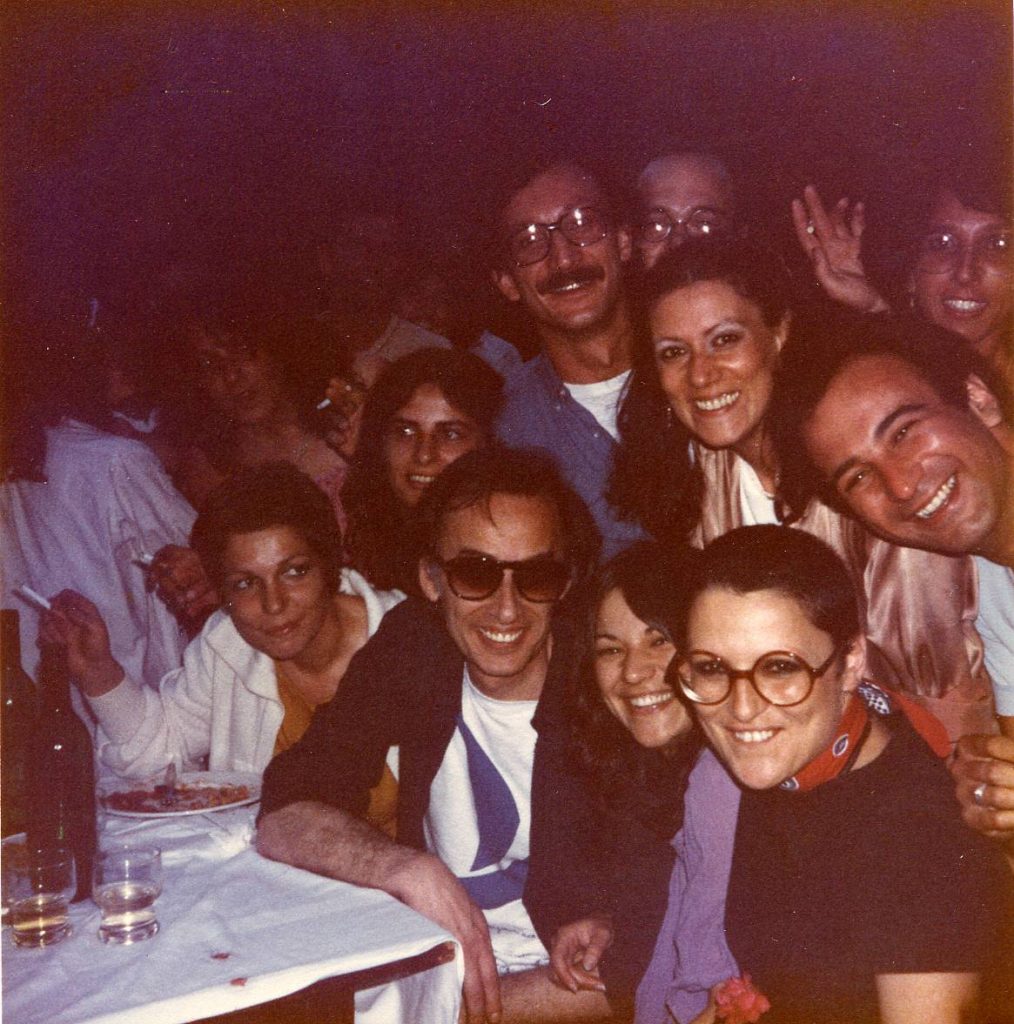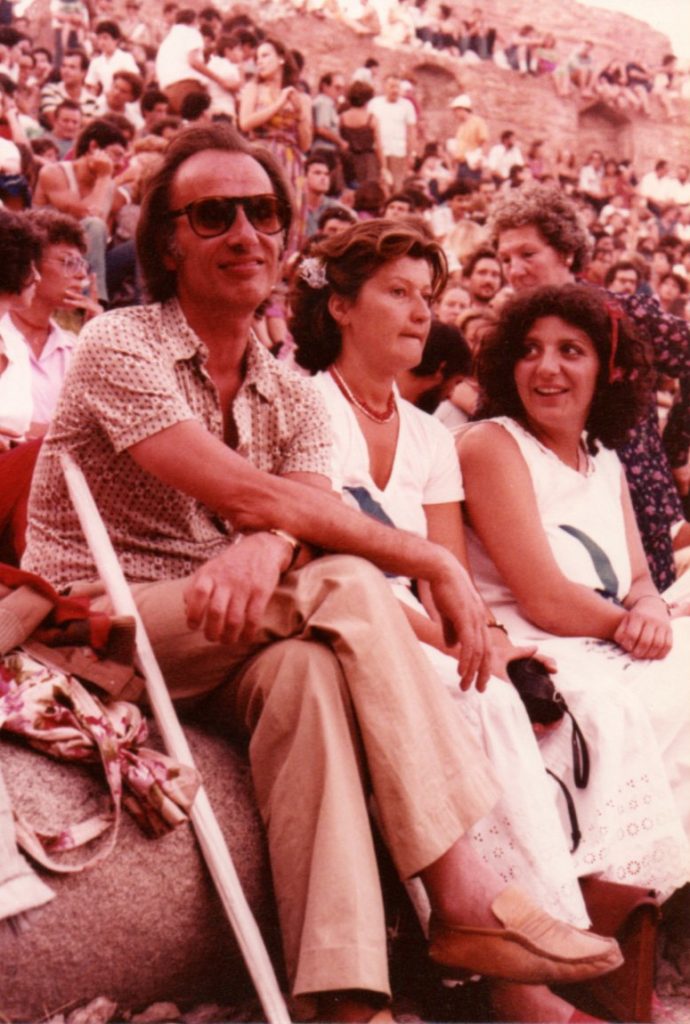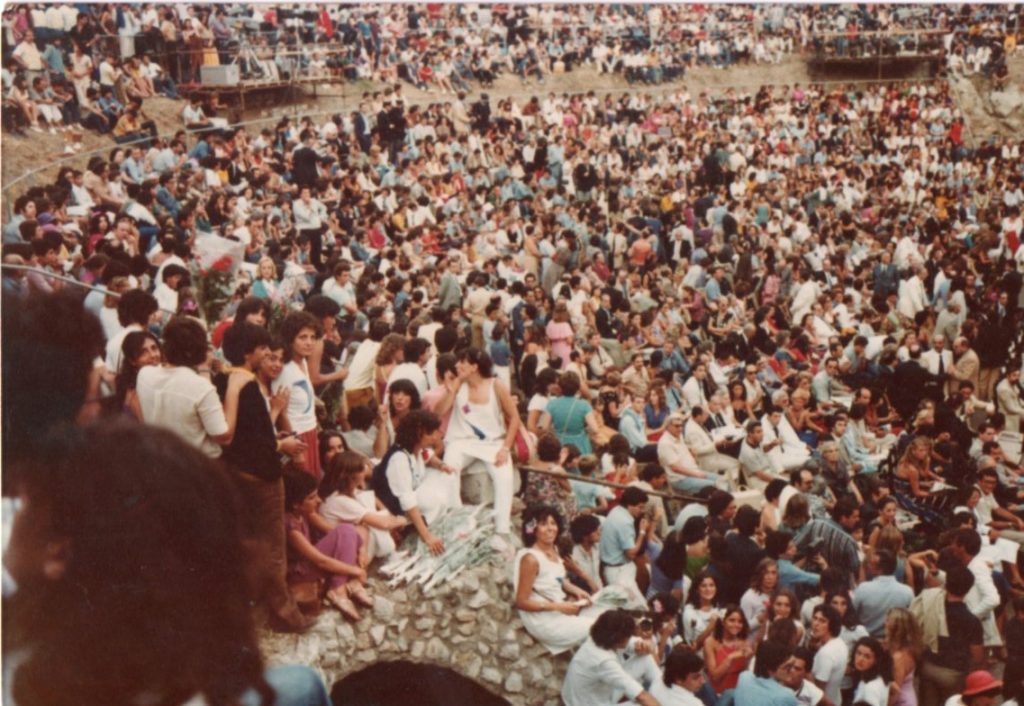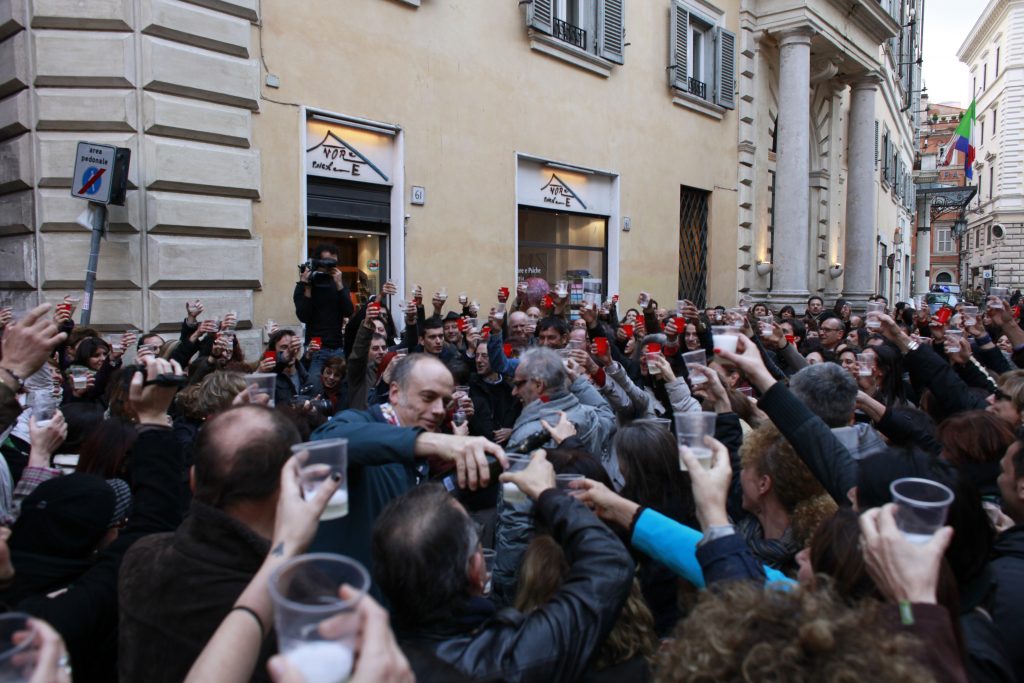“Narrating dreams and asking for their interpretation was an extraordinary phenomenon, which had never happened. And it was a collective and public expression, this is how the seminars of Analisi collettiva started.”
Analisi Collettiva
Go to L'Asino d'oro edizioni website
“People came and asked me for the interpretation of dreams. I only answered this collective request, made by anonymous people.”
Go to Left website
“Analisi collettiva is a monstrum for the interhuman relationship that makes the interpretation of dreams.”
“Analisi collettiva is a creation by a huge number of people.”

© M.Fagioli
THE STORY
On September 23th, 1975, Massimo Fagioli was invited to supervise a group of psychotherapists at the Institute of Psychiatry of the University of Rome Sapienza. The meetings, which were called seminars, were held every Tuesday morning in a room located in the External Unit of the Institute and lasted two hours.
“And, so, in 1975-1976, the story started, and, in addition to the fifteen colleagues who brought me their cases to supervise – ‘I have one patient who says this, does that […]’, ‘Let’s see what can be done, or cannot be done […]’ –, other people, students, etc., started coming. The fact remains that, within two or three months, there were eighty people in a small room. The room in Villa Massimo was half the size of where we are now: it was full to bursting.”
Go to L'Asino d'oro edizioni website
L'Asino d'oro edizioni, Rome, 2018
From the very beginning, however, Fagioli carried out supervision outside the box

“Starting with the fourteen or fifteen analysts whose supervision I was responsible for, who were already aghast because I wouldn’t speak particularly highly of Freud in my interpretations, there slowly arrived all these people. First one, then four, then twelve, until on November 4th, there was the crisis of the official analysts who started to leave while more and more people arrived.”
Go to L'Asino d'oro edizioni website
L'Asino d'oro edizioni, Rome, 2018
“The first crisis occurred on the occasion of a holiday, it was November 4th to be exact, when, more than interpreting, I hinted at separation and indifference. One of the analysts said that, at first, he was feeling fine but, after my talk, he was full of rage: ‘Indifference had been undermined,’ I said. Another analyst spoke about a pathological thought of his where he was lying on a bed in the psychiatry department as if he were a patient, with all the physicians surrounding him. And so, the analysts run away (there was the danger that their hidden psychosis might emerge) and people who were not analysts arrived. A few weeks later, the room was full to bursting. The connection is interesting: as soon as the ‘analysts’ left, people came to undergo analysis.”
Go to L'Asino d'oro edizioni website
L'Asino d'oro edizioni, Rome, 2013
I HAD A DREAM
Within a few weeks, a spontaneous and extraordinary flow of people, common people, without a specific social identity, of different ages, income brackets, and culture, transformed the supervision into a unique phenomenon, which was called Analisi collettiva.
On January 13th, 1976, there was another fundamental moment in the story of Analisi collettiva. Unlike what had happened in November, when his colleagues left the seminar, during a very crowded session, an unknown participant spontaneously narrated a dream. Fagioli did not shy away but rose to the challenge and, breaching the rules of standard psychoanalysis, interpreted the dream; which he went on doing for more than forty years.
“That was the great turning point because, rather than saying, ‘No, the interpretation of dreams happens within private practice […]’, I answered.”
Go to Left website
“I found myself before two phenomena. One: a person – who by the way was also a beautiful girl – who said, ‘I had a dream.’ Two: the fact that, rather than asking for free associations, I threw myself into the interpretation of the dream. I did a thing that had never been done before.”
Go to L'Asino d'oro edizioni website
L'Asino d'oro edizioni, Rome, 2018


The increasingly overwhelming flow of people who crowded into the seminars did not remain unnoticed and drew the attention of the press which started to wonder about this unique phenomenon. On November 9th, 1977, the first three articles appeared in the newspaper Il Messaggero. It was the first time that the term Analisi collettiva had appeared in a national newspaper.
November 9th, 1977. ‘Tutti insieme intimamente’ [‘All together intimately’] (Il Messaggero) with a picture by Michelangelo Giuliani of the room in Villa Massimo street where the seminars where held, with the subtitle: ‘Una seduta di un gruppo di analisi collettiva diretta dal professor Massimo Fagioli’ [‘A group session of collective analysis held by Professor Massimo Fagioli’]; in the same issue, three more articles: ‘Un analista che rifiuta Freud’ [‘An analyst who refuses Freud’](F. Stinchelli); ‘Ecco la cronaca di una seduta’ [‘Here is the report of a session’] (L. Vaccari); ‘Chi è il padrone del discorso?’ [‘Who is the master of the discourse?’](R. Guarini).
March 12th, 1978. ‘Psicanalisi d’assemblea all’università. A Roma è scoppiato l’Anti-Freud’ [‘Assembly psychoanalysis at the university. The Anti-Freud has blown up in Rome’] (Corriere della sera)
ROMA LIBERA street
In order to answer the increasingly greater request for therapy, Fagioli set up additional seminars, which, within a few years, reached the number of four.
“First one session, on Tuesday morning, then two, which rapidly became three, the sessions of psychotherapy increased. Then, I cancelled the old session on Tuesday morning and I recreated (or created) a new one at seven in the evening. After the session on January 10th, 1979, and with the abolition and the recreation of the session on Tuesday, the number of sessions became four.”
Go to L'Asino d'oro edizioni website

“Five years had passed by when a huge conflict arose with Professor Reda, the then director [of the Institute of Psychiatry, Ed.]; so, we could no longer stay there. We didn’t know why, the reasons he gave were ones Berlusconi might give: there were cigarette stubs on the floor, someone had drawn a puppet on the wall. I’ll repaint it myself, no problem! But, no, he thought the university was his own private Institute; he sent letters where he wrote we had to stop everything in about fifteen days… a bit like when you sack your maid. Professor Reda was like that. Should we go on resisting? Then, at a certain point, the big decision: finding my own place and continuing with the work, the cure, the education and research, within my private practice. It was 1979-80.”
Go to L'Asino d'oro edizioni website
L'Asino d'oro edizioni, Rome, 2018
On November 10th, 1980, the seminars moved from the university to a large private practice located in Roma Libera street, number 23. In 1984, the time of each session was extended until it reached 4 hours.
“And, some time ago, I think I said that, for Analisi collettiva, leaving the Institute of Psychiatry was realizing its birth.”
Go to L'Asino d'oro edizioni website
“For almost two years, I looked for a place to save that which, even at that time, was being called Analisi collettiva. Two years during which time psychotherapy sessions were held under the threat that everything would die within a few weeks. Eliminated, cancelled, annulled. It was taken for granted but so many people continued to come and ask for the interpretation of their dreams. And I answered them. In November 1980, we were safe and sat on the wood of unstable benches.”
Go to L'Asino d'oro edizioni website

[It’s a different story! A love story]

[Let oneself fall in love]
GROUP PSYCHOTHERAPY SESSIONS
“I enter through the main entrance in Roma Libera street, I open the doors of the practice and, once they have all arrived, I shut them and the group psychotherapy session starts. They speak one after another, and I listen while observing the expression of their faces, the tone of their voice, which may be more or less high or low, their posture. To the sound of the voice I hear, images arise in my mind; and I transform them into words that reveal the shape that has been perceived in wakefulness; and I also tell the verbal thought that lies within the images. The words of the one who narrates the dream describe the shapes that have appeared in his or her mind, but they bring forth, in my mind, images that reveal the perception of wakefulness before dreaming and verbal thought that is not manifest. The interpretation makes it possible for both perception of wakefulness and latent thought to be known.. […] The conscious recollection of my body going out from the main entrance in Roma Libera street is, actually, awakening because it is restoring one’s own relation with the reality of wakefulness. And we say that, deeply, it is recreation of the end of breastfeeding, meaning of the separation from the mother that is called weaning, standing on one’s own feet, self-sufficiency, ‘doing it ourselves’.”
Go to L'Asino d'oro edizioni website

“And I often repeated a logic: if I had thought I was ill, I would have thought of being ill in my mind and, as an inescapable consequence, Analisi collettiva would have stopped existing a long time ago. It cannot be conceived that, without the certainty of an identity beyond consciousness and reason, someone could have faced the invisible violence of the non-conscious reality of others. For thirty-five years, hundreds and thousands of human beings came and let the violence of their annulment and negation emerge. And, each time I saw a reality that spoke, it was always different and unknown. I always answered because, evidently, I did not think the other was violent. After listening to the voice that narrated dreamlike images, I would see the violence of annulment and of negation. I would name a hidden reality that the other, sometimes, was not aware of. It was not projection because I thought the other was like me, and I thought a human birth was there in him or her that was like the birth that had told me that human beings are born with ‘The unconscious calm sea’.”
Go to L'Asino d'oro edizioni website
“There comes again the question: did it all happen for the unique power, charm, or skill of the psychiatrist? Should it have been the case, I think that, despite it being a wonderful story, it would have been a sad story: a thirty-year-long adventure that could never be repeated as it was too closely linked to the qualities of the person. On the contrary, I find it more interesting and seducing to consider how this composition of conscious reality, and even of social reality, with the liberation of the hidden, primitive, unknown, wild dimensions of human mental reality is linked to and stems from the theory that officially appeared typewritten in January 1971.
“This is because the theory spoke of human birth containing an exclusively human mental reality within itself that then, when it was not lost in destructive relationships, thus, in mental illness, had to realize that which has always been said to be Unbewusste. It all started when, more than thirty years ago, it was ascertained that what was not wakefulness, consciousness and behaviour was no longer unknowable, Unbewusste, rather, it had always been Unbekannt”
Il sogno della farfalla, rivista di psichiatria e psicoterapia, Vol. 4, 2013. p.30
Visit the website of L'Asino d'oro edizioni
SETTING-TRANSFERENCE-INTERPRETATION
“Let’s now try to put all this together. There is the construction of a peculiar arrangement, meaning setting, where one takes a seat for the four hours the group psychotherapy session lasts; there is the analysis of negative transference, meaning the interpretation of negation, and there is the relation with dreamlike images, where evidently, there is no involvement of reason, because reason is so stupid as it has always considered dreamlike images to be sent by Minerva or Apollo […]. In the psychotherapy session, there are these three fundamental elements.”
Go to L'Asino d'oro edizioni website
L'Asino d'oro edizioni, soon to be released
Setting, transference and interpretation have always been the bedrock of the practice of Analisi collettiva.
Setting (a set of contractual and formal conditions that constitute the framework of the psychotherapeutic relationship): that of Analisi collettiva was unique as the psychotherapeutic sessions, defined in space and time, were free, without contracts, obligations, or economic requests; it was only from 1981 that there was the possibility to freely and anonymously contribute.
“Once Analisi collettiva found its own space within a private practice, which entailed an economic burden, at the end of 1981, after more than six years, a personal and absolutely anonymous and free, meaning secret, personal contribution started to be given. This way, the freedom and, even more, the identity of each participant, which was not judged on the basis of economic possibilities, was thus saved.”
Go to L'Asino d'oro edizioni website
“At Villa Massimo, something completely different had happened. The spontaneous flow of these, first tens, then hundreds, then thousands of people who would come, go away, come back, or go away again. And nobody ever did anything: and just as it happened at that time, still today, in Roma Libera street, they can do what they want, I don’t ask for their surname, address or bank details, and, least of all, for their name. For instance, often, it’s I who invents the names, so, I call them, ‘White shirt’ or ‘Red shirt’… as a way to communicate. That’s how this analytic relationship, this unconscious relationship, this transference and countertransference relationship, this therapeutic relationship that I would say is rather delicate, was brought to a dimension of absolute freedom, which doesn’t even exist within normal social relationships, where there is a sort of engagement between one and the other. Here, it has never existed. At my practice in Rome, I don’t even have a telephone, so, if one of them comes or doesn’t come, he or she cannot call me. Immediate relationship, without preconditions.”
Go to L'Asino d'oro edizioni website
L'Asino d'oro edizioni, Rome, 2018
Watch the full video

“I see the practice where we have our sessions and recall the year 2001 when I refurbished the space using light-coloured wood, which led me to sit in the corner that unifies the two large wings. So, there were no longer human beings who could barely hear me without seeing me. Everyone could see the reality of my body and hear the voice that interpreted the dreams that were narrated through the description of dreamlike images. There came the frustration of the pathological thought which might have thought I had something to hide because I hid my body from their sight.”
Go to L'Asino d'oro edizioni website
Transference (relationship, which is mainly non-conscious, which the patient has with the psychotherapist): Fagioli was the first who, against classic psychoanalysis, proposed that the psychotherapist is not the ‘representation’ of the patient’s father or mother. On the contrary, the psychotherapist must hinder the repetition of the previous relationship, thereby allowing the patient to create, over the course of therapy, a completely new and valuable relationship.
“Transference has always been thought to be the reproduction of old parental relationships. Such a relationship, we say, is a false and even a delusional relationship. On the contrary, we have discovered that the analytic relationship is the truest one because it relates to the actual reality of the analyst which is the unconscious reality.”
Go to L'Asino d'oro edizioni website
L'Asino d'oro edizioni, soon to be released
“The transference and countertransference relationship is outlined and accepted in the initial therapeutic contract. Afterwards, every interpretation will be based on this type of relationship. ‘Real events’ are assumed and accepted in the initial contract and are therefore external to the analytic situation.”
Go to L'Asino d'oro edizioni website
“Our dear Sigmund didn’t use the couch but a sort of sommier with one single backrest that is no longer used today but which existed in the nineteenth century and he would let the patient lie there, to then put his hand onto the patient’s forehead, just to do something because, maybe, he wasn’t able to perform hypnosis; and asked the patient to talk, and talk, to carry out what he then decreed as free associations. He then decided to take his hand off the patient’s forehead, possibly, because he wasn’t comfortable, and preferred to relax in an armchair thereby establishing a distance between the patient and the analyst. He eventually tried to theorize this thing by saying that a certain distance was needed between the analyst and the patient, just as the analyst’s impassibility was. Possibly, he had perceived that, mainly when the patient was a beautiful girl, it might happen that, while talking, while confessing, the patient might fall in love with the analyst, and the problem was that there was the need to claim that this falling in love wasn’t real. I have never understood why if there is desire outside the practice, it’s real, whilst, within the psychoanalytic practice, it’s not real; hence, it must be interpreted and avoided by putting a distance and proposing the impassibility of the analyst, who must convince the patient that it isn’t real. Freud wrote about it, thus the word ‘transference’ came out, meaning the peculiar relationship that occurs within the setting, linked to the story of falling in love, of eroticism… of erotomania, the syndrome due to which some people fall in love with the President of the Republic. So, he defined all that which happens within the physician-patient relationship this way.”
Go to L'Asino d'oro edizioni website
Watch the full video
L'Asino d'oro edizioni, Rome, 2018
Università degli Studi "G. d'Annunzio" Chieti - Pescara
Vai al sito de L'Asino d'oro edizioni
Watch the full video
Countertransference (all conscious and non-conscious reactions of the psychotherapist towards the patient)

“When practising psychiatry, countertransference occurs, meaning personal realities of movement and sensibility that, once they’ve been elaborated, once they’ve been seen, can undoubtedly serve for knowledge. Indeed, we are climbing a very slippery slope because there are no objective data, but, I told you that, after I went to Padua – maybe, when I was in Venice, I hadn’t had such deeper relationships – I had to face the fact of considering sensibility as an essential element for knowledge, in particular for psychiatric knowledge. This implied, and again it’s hard to find the words, a distance, a separation that wasn’t separation, from organic medicine because if you are an organic physician, if you treat the heart, the lungs, the stomach or the liver, you don’t need sensibility, actually, if you’re sensitive, you can no longer be a physician; you must be objective, impassive and maybe even indifferent.”

Interpretation (explication of the latent meaning behind the patient’s verbal and non-verbal communications and behaviour): the foundation of the practice of Analisi collettiva was interpretation.
“Thus, as long as it serves to illustrate and clarify this long-lasting phenomenon of psychotherapy known as Analisi collettiva, we insist on highlighting how […] at that place, at the same hour, there starts this unique talk between the psychiatrist and those who I do not like to define as patients but people without a name or a surname who come to ask for something which does not always seem to be the same thing: at times, it is a complaint, at times an accusation, at times the story of a dream, at times a social or political consideration, at times historical research; and the psychiatrist’s answer is always interpretation.”
Go to L'Asino d'oro edizioni website
in Il sogno della farfalla, rivista di psichiatria e psicoterapia, Vol. 4, 2013
According to Fagioli, the main therapeutic instrument is the interpretation of dreams, which he defined as:
“[…] Transformation of conscious thought into non-conscious thought. From verbal thought to thought through images. There are no words, there is no articulated language, dreams are free thought […]. Dreamlike images are never conscious recollections which exactly replicate what has happened in wakefulness, because they create a new image under the stimulation of what has been thought of or experienced in wakefulness, but by transforming it. It is a personal language.”
Go to Left website
Fagioli found that the interpretation of dreams is a key therapeutic element for two reasons: dreams are a language through images and, in psychotherapy, they tell of the relationship (transference) the patient has established with the psychotherapist. Thus, a dream that is narrated within the context of a very large group becomes, through its interpretation, knowledge for all those who take part in the session given the universality of the language of dreamlike images and the relationship with the psychotherapist as a unifying element. This theoretical-methodological approach allowed Fagioli to publically interpret dreams without knowing the biographical data of the dreamers and without using free associations.
Fagioli has always radically refused the Freudian idea about dreams.

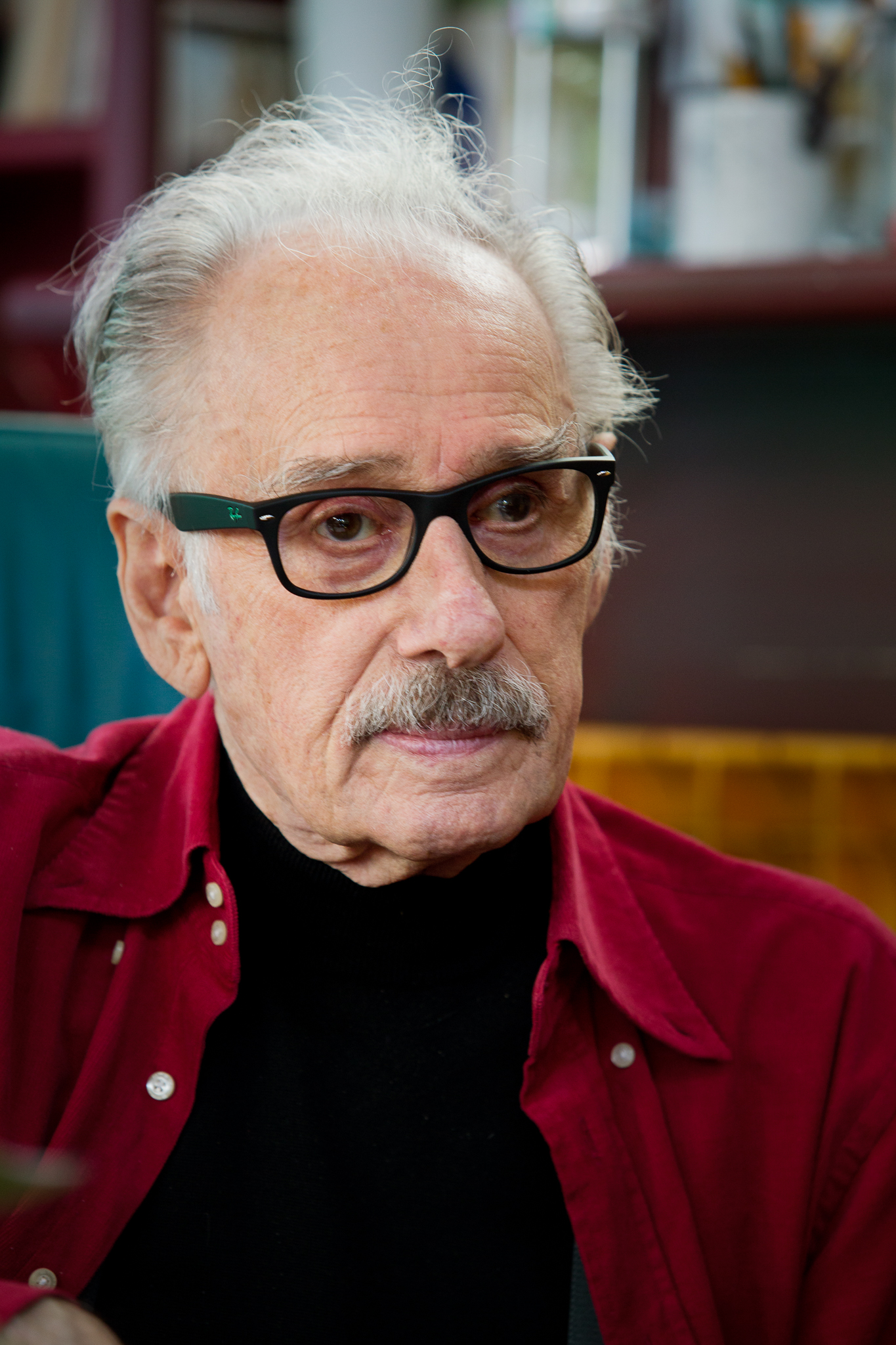
“If dreams are always desires, what need is there to work and treat? Desires are positive and enriching dimensions of human beings. Desire for love, for music, for beautiful literature, etc..”
Go to L'Asino d'oro edizioni website
L'Asino d'oro edizioni, Rome, 2013
“[…] But everything must be derived from patients’ free associations, therefore, if a patient dreams about a dog and says it’s her neighbour’s dog, or her grandma’s dog, or her mum’s dog, or the dog in a dog shelter or a stray dog… one must think that it’s a stray dog. The idea that the dog might be, let’s say, the unconscious representation of her boyfriend, in the sense that he’s like a rabid dog, a pinscher, or a poor little dog at her mercy, is something the analyst must not think. The analyst shouldn’t even think that dreams are representations rather than conscious recollections because, then, they would be his or her delusional pathological thoughts. It’s all written in those hundred or thousand pages.”
Go to L'Asino d'oro edizioni website
Rome, soon to be released
“You started it all by saying that Freud is, basically, an idiot, didn’t you?”
“It all started with three books, with what is now widely known as Human Birth Theory; I showed how Freud hadn’t understood anything about non-material reality and, in particular, about that one third of our life that was called the unconscious […].”
“Freud claimed that dreamlike images are hallucinations, meaning they don’t exist […]. Second, Freud started by saying that dreams are desires, unsatisfied desires, hence, there come hallucinations, and one dreams about making love to Tom, Dick or Harry. There is no desire, in dreams there lies negation! […]”
“And you claim that, through the interpretation of dreamlike images, it’s possible to cure some psychiatric illnesses, don’t you?”
“I’ll tell you something personal. […] After the six-week summer break […] I was flabbergasted, astonished, ‘The holidays went fine, I’m no longer depressed’. […] People said this over and over again, ‘I’m no longer depressed’”
“What was it due to?”
“Eh, now, what is it due to? It’ll be the work for the next forty years! Up until now, we’ve had to discover why one becomes ill, now, we have to discover why one is healed and feels well, gets over depression. […] We’ve always been under a thousand-year-old oppression, starting from original sin, from Kant’s radical evil, from the concept of animality in Western logos, from the nothing of Hebraic mystics: the oppression for which within ourselves there lies evil, ‘the lack of’, something we are born with. This is completely false! The evil that comes is due to interhuman relationships, mainly during the first year of life when the relationship doesn’t work.”
“Do you think it’s the first year of life that is decisive?”
“It’s the first year of life that is decisive.”
“But, what can we do?”
“What can we do? Give women back their identity, because it’s women who bring babies into the world and, nine times out of ten, they give them milk during their first year of life, even if it’s now only six months. Because they haven’t got an identity, because Western logos, the rational human identity has always negated the human identity of women. […] Starting from this point to say: all births are equal.”
Go to L'Asino d'oro edizioni website
Watch the full video
Go to L'Asino d'oro edizioni website
Watch the full video
CURE-EDUCATION-RESEARCH
That which Analisi collettiva has built and carried out over the last forty-one years, based on the three pillars of setting, transference, and interpretation, can be summarized in these three words, which are indissolubly intertwined with one another despite their different meanings:
“It was on March 20th, 1985, that, when talking in Naples, I said, off the top of my head, ‘Cure, education, and research‘.”
Go to L'Asino d'oro edizioni website
“We said these words to each other without realizing what we were saying […], three words that do not sit well together.”
Go to L'Asino d'oro edizioni website
Therapy was rigorously carried out within the four hours each group psychotherapy session lasted for, and can be defined as a process of personal transformation that happened through ‘the disappearance fantasy’ towards one’s own diseased internal dimensions.
“The proposition is the following: disappearance of one’s own internal dimensions of relationship. In other words, going beyond the concept of awareness and control. Once what is negative in human beings has been found, once partial, sadomasochistic and masturbatory dimensions of relationship have been found, the dialectic will be refusal that allows for these dimensions to disappear. […] Therefore, a continuous practice of interpretation and refusal of what is inhuman that is aimed at making non-transformative dimensions – the lack of affectivity, envy and greed – disappear […].”
Go to L'Asino d'oro edizioni website
L'Asino d'oro edizioni, Rome, 2013
“[…] On the contrary, discovering negative transference can trigger a thought that I consider to be extraordinary, meaning finding the reason behind mental illness: ‘You are diseased because you hate me, because you annul me,’ and so forth. In other words, mental illness that appears suddenly, one does not know where it comes from or what it is and where it leads to, becomes, on the contrary, a precise discourse that is guided through transference, and this is true for all destructive dimensions […]; this implies that one thinks mental illness is not freedom of expression but a destructive dimension […].”
Go to L'Asino d'oro edizioni website
L'Asino d'oro edizioni, di prossima pubblicazione


Education is a term that, according to Fagioli,
“Implies individual subjectivity that is absolutely free and independent; it implies multidirectional research, it implies dimensions and realities coming from various experiences.”
“[…] He goes to Paris to be a painter. The next day, he realizes it is not a good idea, and changes and goes to Berlin. Then, he changes Berlin and decides that, for his education, he must go to New York. One must study literature, work as a farmer, then, as a goldsmith. One must abandon the father, do many things, in a condition of complete freedom, taking all the responsibility for failure, for all the failures, or, possibly, for the successes.”
Go to L'Asino d'oro edizioni website
rivista di psichiatria e psicoterapia, Vol. 1, 2002
In this dimension of free relationship (apparently in contradiction with the therapeutic relationship, which is a precise relationship between the psychotherapist and the patient, where responsibility is almost exclusively the psychotherapist’s) there occurred the overcoming of and the separation from one’s own pathological dimensions, which became, for every participant of Analisi collettiva, knowledge about his or her own and others’ human reality to invest in personal and social relationships. For hundreds of psychiatrists and psychologists, this course of personal therapy and the knowledge acquired have become the basis of their psychotherapeutic activity.
And finally, there is the word ‘research’: within this therapeutic and educational relationship, research has always been carried out into the normal and pathological, conscious and non-conscious, functioning of the human mind, into the deep dynamics involved in interhuman, private and social, relationships, into psychiatry and dominant culture, which have always hindered the progress of the science of the mind. For instance, within Analisi collettiva, Fagioli continued, collectively, the research he had started alone decades earlier.
“It was because, in the first few years, the definition Analisi collettiva was not so clear cut. And I said, ‘Annul the fact that I’ve written three volumes of theory. Let’s start research together.’”
Go to L'Asino d'oro edizioni website

“The word research is linked to the image of a solitary scientist who has a relation with reality that is intelligent, original, thus he or she discovers things that have not been seen before. It is hard to associate experimental, biological research with people who get together, who often fight amongst themselves, whereas we say this is something indispensible in psychiatry. […] In psychiatry, one mental reality meets another mental reality, there is an encounter, and within this encounter there is undoubtedly research where, unlike what happens with a biologist, active dynamics involve both partners and interact with each other. […] Thus, research must be carried out with a different method and, maybe, even before the discovery of a different method, in order to carry out research, the psychiatrist must find his or her own identity of thought that is different from the identity of a medical-biological scientist.”
Go to L'Asino d'oro edizioni website
L'Asino d'oro edizioni, soon to be released










